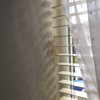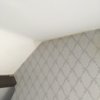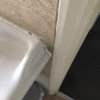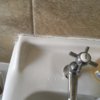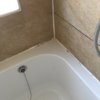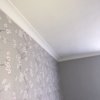- Joined
- 13 Jul 2019
- Messages
- 12
- Reaction score
- 0
- Country

Further to my previous post as I couldnt upload more picture...
Damp - So as you can see in the pictures in the attic chimney breast wall there are two patches of damp. The chimney stack was re-bricked and rendered about a year ago. The first damp patch appeared about 3 months ago and a roofer came, had a look, said the flashing / leading / roof tiles looked fine and suggested capping the chimney pots as the solution. This seemed to have worked as the first patch started to dry and hasn't got any bigger. Since then though the second patch appeared. Could this be trapped water finally soaking through? Any ideas about this?
There is also a patch of damp next to the kitchen window, which seems related to condensation. Does this need replastering or can it be sealed and repainted somehow? Suggestions on the best approach to what to do with this would be great.
_________
Sealing bathroom silicone. As you can see this needs replacing. Can I just go over it or do I need to remove it all first. What product would you recommend to use for it. A lot of the grouting is cracked missing aswell in the bathroom tiles. Can this just be patched up with ready made grout?
________
Lastly and of most concern to me, the floors are very bouncy in the attic bedroom and first floor bedroom. The first floor bedroom also has an original lath and plaster ceiling (It looks fine-see picture) but I'm worried about its lifespan and if its just going to collapse one day. I understand the only option is to overboard or pull it down, but since we live in it there's no chance we can pull it down. Based on the springiness of the floor I would also be worried about loading additional weight on it by overboarding. I have no idea about the condition of the joists either. I don't really know what to do about this or even what kind of trader to contact.
Thanks again if anyone has any ideas about any of these issues.
Alex
Damp - So as you can see in the pictures in the attic chimney breast wall there are two patches of damp. The chimney stack was re-bricked and rendered about a year ago. The first damp patch appeared about 3 months ago and a roofer came, had a look, said the flashing / leading / roof tiles looked fine and suggested capping the chimney pots as the solution. This seemed to have worked as the first patch started to dry and hasn't got any bigger. Since then though the second patch appeared. Could this be trapped water finally soaking through? Any ideas about this?
There is also a patch of damp next to the kitchen window, which seems related to condensation. Does this need replastering or can it be sealed and repainted somehow? Suggestions on the best approach to what to do with this would be great.
_________
Sealing bathroom silicone. As you can see this needs replacing. Can I just go over it or do I need to remove it all first. What product would you recommend to use for it. A lot of the grouting is cracked missing aswell in the bathroom tiles. Can this just be patched up with ready made grout?
________
Lastly and of most concern to me, the floors are very bouncy in the attic bedroom and first floor bedroom. The first floor bedroom also has an original lath and plaster ceiling (It looks fine-see picture) but I'm worried about its lifespan and if its just going to collapse one day. I understand the only option is to overboard or pull it down, but since we live in it there's no chance we can pull it down. Based on the springiness of the floor I would also be worried about loading additional weight on it by overboarding. I have no idea about the condition of the joists either. I don't really know what to do about this or even what kind of trader to contact.
Thanks again if anyone has any ideas about any of these issues.
Alex


